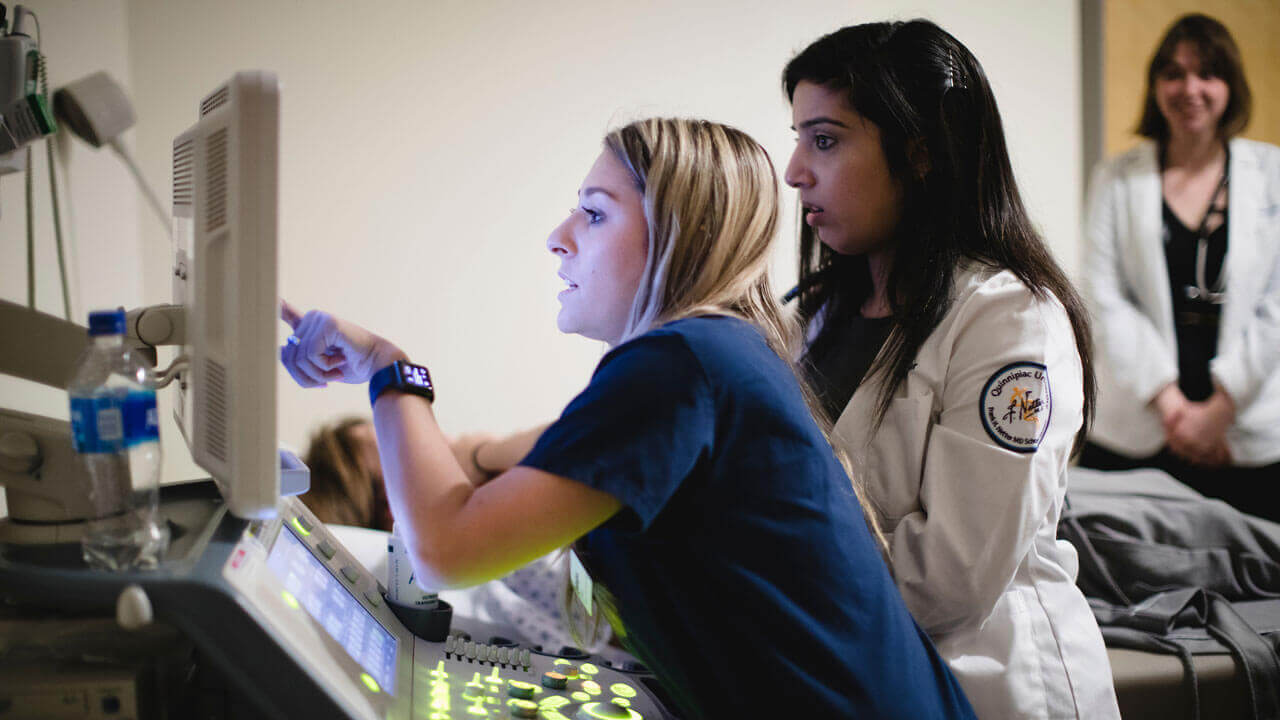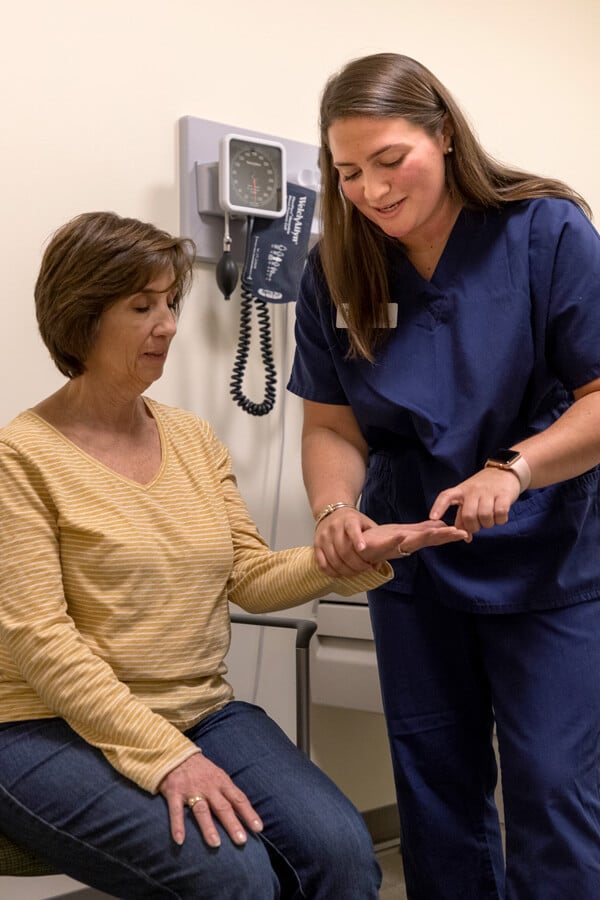
Quinnipiac SPAC training program teams up with Special Olympics Connecticut athletes
June 24, 2025
The Standardized Patient and Assessment Center (S-PAC) hosts 16 patient exam rooms, an examination demonstration room and a medium-sized classroom. Students and faculty at the Netter School of Medicine utilize the space for experiential teaching and learning as well as the assessment of clinical skills, ultrasound training and basic procedural training.

A wide variety of curricular elements, scenarios and scripts are used in any of the following modalities for the purposes of teaching as well as formative and summative assessments.
Standardized patient encounters provide a safe environment for learners to practice and simulate skills such as recording history and performing physical and mental exams. Students also form advanced communication skills as they practice delivering bad news, screening for intimate partner violence and navigating complex behavioral health encounters.
Live-action simulations encompass events where standardized patients portray a patient in a classroom and/or workshop setting with a group of students and faculty. These events are largely designed for learners to work on obtaining new skills within the domain of interviewing, communicating, and medical decision-making. Standardized patients may be provided a regular script or a character/situation summary to improvise.
Objective Structured Clinical Exam (OSCE) cases are built in collaboration with the specific curricular needs of the program. The standardized patients’ roles during an OSCE are to memorize a script, accurately portray the script and complete an assessment of the learner in a timed or untimed format. A central component of the OSCE is the ability of the standardized patient and/or the faculty member to provide feedback to the learner based on a checklist that is constructed by the faculty requiring the assessment as well as standardized patient observations made in the encounter.
The OSCE can be used to assess multiple dimensions of learner performance including history taking, physical examination, communication, procedural skills, problem solving and decision-making.
Utilizing recording and assessment capability available through the institutional CAE/Learning Space software, learners are provided with video feedback as well as numerical data to support competency-based feedback on their OSCE performance.
Hybrid simulations are experiences involving the use of standardized patients to augment high-fidelity manikin encounters with a task trainer simulator. Events include rapid response and cardiac arrest simulations as well as telehealth encounters. Interprofessional opportunities for learning are available in the School of Nursing and the School of Health Sciences.
Task trainers are utilized by faculty and learners to train or practice a specific skill such as physical exam (ear/eye simulations, heart/lung simulations, rectal/pelvic models) as well as procedures such as endotracheal intubation, central venous line placement, suturing, IV insertions, lumbar punctures, ABG, trainers for incision and drainage of abscesses and more.
A portable Butterfly IQ+, Philips Lumify and various other ultrasound equipment are available for training purposes. Students can learn the basics of point of care ultrasound with model patients. Interprofessional opportunities for learning are available with assistance from the diagnostic medical sonography teaching program.

General Standardized Patient: These individuals are part-time temporary employees of Quinnipiac who are trained to play the roles of patients, family members, healthcare providers or others in a consistent fashion for the purposes of clinical simulation. There are currently 100 standarized patients employed by Quinnipiac who work in various capacities to allow participants to practice history taking skills, physical exam skills communication skills and more.
Gynecologic Teaching Associates: These individuals are trained for standardized gynecological exam training sessions for both breast and pelvic exams. Experiential learning and teaching sessions for students include patient-centered communication skills, as well as immediate feedback from the associate.
Urologic Teaching Associates: These individuals are trained for standardized rogenital exam training session for male genitals (lymph nodes, penis, scrotum, testicles), hernia exam and prostate exam. Experiential learning and teaching sessions for students include patient-centered communication skills, as well as immediate feedback from the associate.

June 24, 2025
Students in the diagnostic medical sonography program participate in simulation with their peers, manikin simulators and phantoms in the sonography laboratory across the diagnostic medical sonography curriculum. Laboratory experiences provide opportunities for students to develop and practice clinical skills in abdominal, OB/GYN, breast, vascular and musculoskeletal sonography examinations. Students also demonstrate competence in performing sonographic examinations by completing simulation assessments at many points across the undergraduate curriculum. These are practical examinations where student peers, manikin simulators or phantoms serve as authentic patients.
Students in the occupational therapy programs use standardized patients to develop and practice clinical skills in screening, assessment and intervention. Elements are woven into the curriculum to provide hands-on learning experiences, including mobilizing patients with lines and tubes. These opportunities also incorporate skills such as critical thinking, time management, communication, active listening, empathy and professionalism.
BS in Health Science Studies / Master of Occupational Therapy
Post-Baccalaureate Master of Occupational Therapy
BS in Health Science Studies / Doctor of Occupational Therapy
Students in the physical therapy programs participate in simulation with standardized patients across the physical therapy curriculum. Laboratory experiences with standardized patients provide opportunities for students to develop and practice clinical skills in examination and intervention. Students also demonstrate competence by taking Observed Structured Clinical Examinations (OSCEs) at many points across the graduate curriculum. These are practical examinations where standardized patients serve as authentic patients.
Throughout the physician assistant didactic phase, students engage in dynamic simulation sessions embedded across multiple courses, bringing classroom knowledge to life. These simulations create realistic patient encounters based on medical conditions covered in courses, offering invaluable practice in history taking, physical examination, differential diagnosis, lab and diagnostic interpretation, clinical decision-making and patient education. In addition, physician assistant students use simulation to practice interprofessional, team-based healthcare with students of other disciplines within the Quinnipiac community.
Students in the social work program participate in simulation with standardized patients across the curriculum. Experiences with standardized patients provide opportunities for students to develop and practice engagement, assessment and intervention skills in a safe learning environment. Students receive real-time feedback from standardized patients, their instructor, their internship supervisors and their peers to promote professional growth.
Students enrolled in the traditional and accelerated nursing programs participate in simulation-based learning across the curriculum. Students work with standardized patients to practice therapeutic communication during laboratory and on-campus clinical courses.
Students in the nurse practitioner programs engage in authentic patient interaction with standardized patients across the curriculum within our Standardized Patient and Assessment Center. Students develop and demonstrate skills of holistic, person-centered care such as history taking, assessment, physical examination, diagnostics and therapeutic communication. These experiences develop confidence and competence to meet patient care needs within diverse communities.
Adult-Gerontology Acute Care Nurse Practitioner
For information about becoming a standardized patient or about planning a standardized patient education event, please email Gabby Ceccolini, director of the standardized patient and assessment center.
The S-PAC is not currently used for actual patient care or clinical research. Requests for use must be submitted ahead of the start of each semester.
We’re always here to help provide additional information and answer any questions you may have.
Keep up to date with the latest information about the School of Medicine.
Quinnipiac Today Opens in a new tab or window. Events Calendar Opens in a new tab or window.